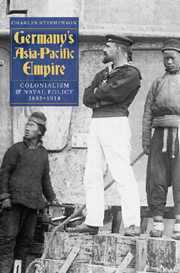Book contents
- Frontmatter
- Contents
- List of Illustrations
- List of Maps and Tables
- Introduction
- 1 Bismarck and Empire: 1885–1888. Kaiser Wilhelm's Land, the Bismarck Archipelago, the Marshall Islands and Nauru
- 2 The Acquisition of Kiautschou: 1897
- 3 China 1897–1914: Colonial Development and Political Turbulence
- 4 Tectonic Shift 1: 1898–1899. Spain and the USA, Germany, Micronesia and Samoa
- 5 Tectonic Shift 2: 1902–1914. Japan and Russia, Britain and Dominion Defence, the United States
- 6 War. August 1914
- 7 Naval Plans and Operations 1897–1914
- 8 Kiautschou: Naval and Military Operations 22 August–28 September 1914
- 9 Tsingtau: Naval and Military Operations 28 September–7 November 1914
- 10 Aftermath
- Notes to the Text
- Bibliography
- Index
2 - The Acquisition of Kiautschou: 1897
Published online by Cambridge University Press: 12 September 2012
- Frontmatter
- Contents
- List of Illustrations
- List of Maps and Tables
- Introduction
- 1 Bismarck and Empire: 1885–1888. Kaiser Wilhelm's Land, the Bismarck Archipelago, the Marshall Islands and Nauru
- 2 The Acquisition of Kiautschou: 1897
- 3 China 1897–1914: Colonial Development and Political Turbulence
- 4 Tectonic Shift 1: 1898–1899. Spain and the USA, Germany, Micronesia and Samoa
- 5 Tectonic Shift 2: 1902–1914. Japan and Russia, Britain and Dominion Defence, the United States
- 6 War. August 1914
- 7 Naval Plans and Operations 1897–1914
- 8 Kiautschou: Naval and Military Operations 22 August–28 September 1914
- 9 Tsingtau: Naval and Military Operations 28 September–7 November 1914
- 10 Aftermath
- Notes to the Text
- Bibliography
- Index
Summary
There was a pressing need, as viewed from the German Admiralty, for a permanent base in the Pacific area to accommodate the vessels of the East Asiatic Cruiser Division. A precursor to this force had been formed in the early 1880s, and its importance had grown commensurately with the acquisition of colonial territories. It became a permanently constituted unit in September 1894 following the outbreak of the Sino-Japanese War the previous August. Contemporary practice designated a division as a four-ship unit under the command of a rear admiral; the first holder being Paul Hoffman who took up position in November. The four warships in the command comprised three Carola-class iron flush-decked corvettes, Alexandrine, Arcona and Marie, and the newer Irene II-class protected cruiser-corvette Irene. Hoffman's orders enjoined him to protect German interests in the region generally, and to seek out potential sites for a permanent base.
Both the composition of the Cruiser Division, the Carola-class vessels were obsolete when constructed, and the lack of dedicated facilities greatly hampered the operational efficiency of the unit. It was however easier to increase the potency of the division by attaching more powerful vessels to it, Alexandrine and Marie being replaced by the Kaiser-class central battery ironclad Kaiser and Prinzess Wilhelm, sister of Irene, in January 1895, than it was to establish a permanent base. Hoffman's successor, from 1896, was Rear Admiral Alfred von Tirpitz, and as he was to later put it: ‘The lack of a base hampered us because the sole factor of power […] was our flying squadron [sic], and the existence of this depended upon the Hong-Kong docks and consequently upon the favour of Britain.’
- Type
- Chapter
- Information
- Germany's Asia-Pacific EmpireColonialism and Naval Policy, 1885–1914, pp. 17 - 30Publisher: Boydell & BrewerPrint publication year: 2009

